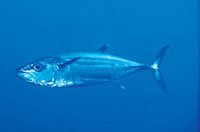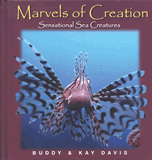Elite Swimmers
Streamlined Fish a Puzzle for Evolution
Originally published in Creation 27, no 1 (December 2004): 40-41.
Two very different fish kinds, tuna and great white sharks, have been found to have a very similar body shape,1 enabling them to swim really fast with minimal effort.
Their bodies are so well streamlined that the curvature and tapering offers the least possible resistance to moving through the water. This amazingly efficient design, and the way it is achieved, sets them uniquely apart from almost all other fish. Both have muscles and tendons arranged in very similar fashion.
Most fish swim by contracting muscle blocks in a wave along the whole body length, eventually moving the tail. This is good enough for what they do, but is limited in power because the muscles have to bend much of the fish’s body. But tunas and makos have high-endurance ‘red’ muscle concentrated near the centre of the body. Long tendons connect this directly to the tail, so it can move with great force.
 |
 Photos by Gary Bell, <www.oceanwideimages.com> |
What puzzles evolutionists is how two such different creatures could have each evolved the same ideal shape and mechanism. They have quite different internal structure. Tuna have a bony skeleton, while sharks have cartilage. They are supposed to have diverged from one another a very long time ago. One of the researchers, Professor Robert Shadwick, of the Scripps Institution of Oceanography, said, ‘It’s a fairly major change in anatomy to have that happen. That is the thing that makes it remarkable to us, that this arose independently in the two fish.’
Similar structures in different creatures are usually described as homologous. This is because it is believed that the creatures have descended from a common ancestor which had that particular feature. But evolutionists realize that fish as different as sharks and tuna have no traceable common ancestor which could have had these features, even if evolution were true. People suppose that they diverged from one another over 400 million years ago, and followed quite different paths of development. That leaves the question unanswered of how their shapes, and the muscular arrangements giving rise to them, are now so similar. Evolutionists call this phenomenon ‘parallel’ or ‘convergent’ evolution, and they have to ascribe it to an identical chain of mutations, and associated environmental pressures, occurring at just the right time over millions of years—by sheer chance.
The alternative explanation, which makes more sense, is that both kinds of fish were made by the same Designer. God, who created water, knows how it flows around the body of a moving object, and knows the best shape for fast-swimming fish. He is able to give them a really streamlined shape should He choose to. Indeed, with all our modern science, hydrologists have not been able to come up with a better one!
We can recognize the hand of a common designer in man-made objects, whether they are art works or manufactured articles. Art experts can often pronounce with confidence on the question of who painted a particular work, because they can recognize the same techniques used in producing paintings. In the same way, we ought to be able to recognize the hand of our Maker in the wisdom of the way He has made living things (Romans 1:18–32).
Resemblance: more than skin deepThe similarity between the streamlined shapes of tuna and certain sharks (mako, great white) is no coincidence. Both have special muscles for sustained swimming that move independently of the surrounding tissue, and the muscle force is transmitted through unusually long tendons. These systems are ‘unlike virtually all other fishes’.1 This cannot be explained by evolution’s ‘common ancestor’ catchcry (see main text).
|
Recommended Resources

Answers in Genesis is an apologetics ministry, dedicated to helping Christians defend their faith and proclaim the good news of Jesus Christ.
- Customer Service 800.778.3390
- Available Monday–Friday | 9 AM–5 PM ET
- © 2026 Answers in Genesis


